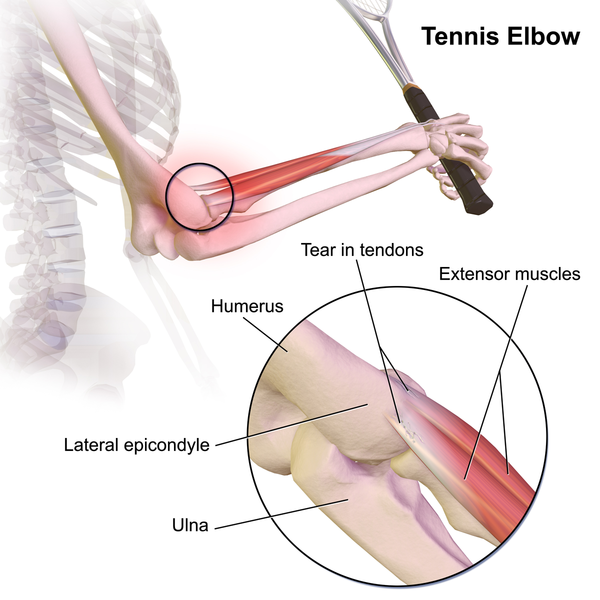Tennis Elbow and Strings

Just so we're clear, if you have tennis elbow, changing your strings won't get rid of it. It will help to reduce the vibration that you experience which can in turn reduce the pain. At this point if you have tennis elbow, you have a few options, the two I recommend are rest or visiting a physio/physical therapist. (In my other blog called Cork Tennis, I was lucky enough to know a very good physical therapist, who wrote an article for me about Tennis Elbow. You can read it by following this link.
Strings will definitely help lessen the chances of you getting tennis elbow but you need to understand that strings are only one of the factors that can cause it. The others are the type of racket you use, your technique and also your grip size.
If you are someone who is prone to getting tennis elbow, changing your strings or a bit of coaching are a good place to start as both are cheaper options than changing your racket.
Your racket does play a big part in tennis elbow and depending on it's features, your chances of getting it increase or decrease accordingly.
Generally a head heavy, lightweight racket cause most problems, as do rackets with thicker frames. These offer less in the way of absorbtion than heavier or thin framed rackets.
Stiffer rackets will also transfer a greater amount of shock to your arm and are more prone to twisting on impact, which also increases the chances of getting tennis elbow.
Be sure when buying a racket to ask plenty of questions of the sales assistant. Also ask about the option to trial the racket. Where I used to work we had a 'Buy and Try' policy. This allowed the customer the opportunity to take the racket away and test it in a proper environment. We wanted to make sure each customer was happy with their choice.
Your grip size also has a part to play in tennis ellbow. If the grip is too small, the racket can twist in your hand on impact and this would put stress on the wrist and elbow. If the grip is too big, you are straining the muscles of the forearm trying to hold onto it again putting unnecessary pressure in and around the elbow. The best advice I can give, as everybody usually fits into 2 grip sizes, is to err on the small side as building up a grip is easier than reducing it.
The last factor, before we get onto strings, is technique. Some people even if they have everything else right can still get tennis elbow due to poor technique. The best way to address this is to pay a visit to your coach. They will be able to address the areas of your swing that need fixing and hopefully resolve the problem for you.
So with all that being said, what part do strings play in tennis elbow?
Quite an important part really!
In recent years with the increase in popularity of polyester strings, there has being an increase in arm injuries. It makes sense that if a stiffer racket is going to increase your chances of getting tennis elbow then the same would apply to stiffer strings.
Here are some features you should be looking for in an arm friendly string:
- A thinner gauge
- Softer string
- Lower tension
Thinner Gauge:
Gauge refers to the thickness of the string. The most commonly used gauges are 16 and 17, but you will also find players using anything from 15 to 19. Each figure equates to a measurement in millimetres, as shown below.
| 15 | = | 1.41-1.49 mm | 17 | = | 1.20-1.24 mm |
| 15L | = | 1.34-1.40 mm | 17L | = | 1.16-1.20 mm |
| 16 | = | 1.26-1.33 mm | 18 | = | 1.10-1.16mm |
| 16L | = | 1.22-1.26 mm | 19 | = | 1.00-1.10mm |
While there isn't a huge difference between the thinnest and the thickest, there is a noticeable difference in feel when you hit the ball.
Thinner strings are more elastic (comparing like for like), offering more power but more importantly, in this case, a more forgiving and absorbent stringbed. They increase the size of the sweetspot, reducing the amount of shock and vibration transmitted to the arm/elbow.
String Type:
You don't need to be a rocket scientist to know that if you are looking for more absorbtion in your strings you will be looking for softer strings.
Top of this list is Natural gut, the nicest and most absorbent strings available. Unfortunately also the most expensive, but if you want the best it comes at a price.
A very good substitute for Natural gut is a string type called Multifilament, which is available at much keener prices.
Multifilament is a very soft string that is made up of multiple filaments of string bundled together similar to that of Natural gut. These wrap around strings compress on impact and dilute the vibration travelling up your arm. Definitely one of the most comfortable strings available to those battling with tennis elbow.
Lower Tension:
Lowering the tension of the strings helps reduce the stiffness of the stringbed, and as mentioned earlier stiffness is one of the main contributors to tennis elbow. When you lower the tension the stringbed will deflect more, providing a softer feel and a larger sweetspot. This in turn reduces the amount of vibration.
So you can see how there are a number of factors that affect tennis elbow, but by choosing the correct string and tension you lessen the chance of it happening to you.
A good stringer will know all of this and will guide you through the process. Be sure to always deal with qualified stringers, they have put in the time and the effort to make sure the job is done right.